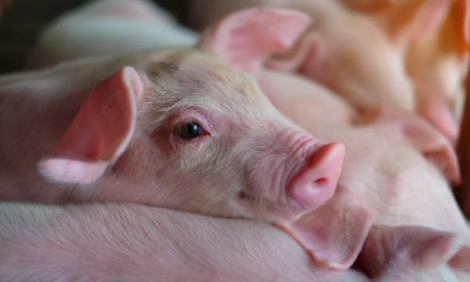



Production Costs in International Pig Production
Production Costs in International Pig Production - The National Committee for Pig Production, Denmark - The competitively strong countries currently experience a great expansion in pig production. This development is brought about by the liberalisation of the global trade of pig meat and by the low costs in the primary production. Hence, the costs in the pig industry were studied in a number of the countries that Danish pig production is often compared with. This paper primarily deals with the most important element of competitiveness: the costs of pig production.Results of study
The results of the production cost study are calculated per kg carcass, this provides a coherent
figure that is compatible across countries. Figure 1 shows the total production costs per kg carcass in DKK currency.

Figure 1. Production costs in 2000 in selected countries.
The countries have been arranged according to their level of costs starting with the lowest costs. Canada has the lowest production costs corresponding to approx. DKK8 per kg carcass, while the costs in the USA and Ireland are approx. DKK1 higher per kg. France, Denmark and the Netherlands belong to the group of countries with medium-sized costs, while Germany and in particular Sweden and the UK have very high costs. From 1999 to 2000 dramatic changes took place in the costs in Germany and the Netherlands. The Dutch level of costs has increased and the country is approaching the countries with high costs. Germany, however, tends to approach the countries with medium-sized costs.
Cost categories
Feed
Below the most important cost categories will be dealt with. The efficiency in production
will be dealt with in the categories where it is of great relevance. An outline of the feed costs
in the individual countries is shown in Figure 2.

Figure 2. Feed costs per kg carcass.
The feed costs are one of the most important cost categories, as it normally constitutes more
than 50% of the overall costs. The overall feed costs are feed for sows, weaners and finishers.
The feed costs are affected by feed consumption, feed prices, slaughter weight and number
of produced pigs. The most important period with respect to feed consumption is the
growth period.
As can be seen from Figure 2, Canada has the lowest overall feed costs, closely followed by
the Netherlands and the USA.
In Canada and the USA the feed costs are low, which affects the overall feed costs dramatically.
In the Netherlands, the efficiency in pig production greatly contributes to the low feed
costs per kg carcass. In particular the number of pigs produced is very high and there is a
sound feed conversion in the finisher period.
Germany has relatively low feed costs as the German feed prices have not increased as much
as in other countries in the last years. Furthermore, the feed efficiency in the finisher period
improved drastically from 1999 to 2000. The feed costs are furthermore affected by a very
high slaughter weight. This means that the feed consumption can be split onto more kilos of
carcass and thereby the cost per kg carcass drops.
Denmark also has a relatively low level of feed costs, which is primarily due to a good feed
efficiency in the finisher unit.
Sweden has slightly higher costs than Denmark caused primarily by a high feed consumption
in the sow unit.
The UK and Ireland have high feed costs. This is due to the fact that both countries slaughter
the animals at a low weight and feed the pigs a very high content of protein. The high con-
tent of protein contributes to increase the feed price in both the UK and Ireland. The British
argue that this is because they import most of the protein. Other matters related to the feedstuff
industry also contribute to high feed prices. This will be described in details later.
Feed efficiency
Factors that affect the feed costs will be dealt with in this section. Figure 3 shows the feed
conversion in the individual countries.

Figure 3. Feed conversion in the finisher period, kg feed per kg gain.
The feed efficiency of the individual countries cannot directly be compared due to differences
in the content of the feed and in start and finish weight. It does, nevertheless, give
some idea of the level of the feed efficiency.
As seen in Figure 3, the Netherlands has the best feed conversion with a slaughter weight of
87 kg. As mentioned previously, the efficiency is characterised by cessation arrangements
where the most inefficient pig producers have resigned.
The UK and Ireland have a low feed conversion, which is connected to a low slaughter
weight. Denmark has a relatively good feed conversion, but to reach the top level, improvement
is needed.
Canada and Germany differ from the rest of the countries by having a distinctly poorer feed
conversion. Even though feed is fairly cheap in Canada, the feed efficiency is of great importance
to the costs.
It has not been possible to obtain reliable figures for the efficiency of the feed conversion in
the USA. It is, however, expected to be at the same level as or poorer than Canada.
Feed prices
Figure 4 shows the prices of finisher feed in selected countries.

Figure 4. Prices of finisher feed.
During the last years the feed prices in Germany have not increased as much as in the surrounding
countries, e.g. Denmark. This means that the production costs of the German pig
producers have increased less compared to other countries.
Figure 4 shows that the price level of finisher feed is significantly higher in Ireland and the
UK. According to Irish1 and British agricultural economists2 this is a result of the fact that
basically all feed is imported. A report on Irish feedstuff industry made by the Teasagc organisation
points to several factors that put a strain on the feed prices1. Transhipment
charges in Irish port are higher than in many other European ports. Furthermore, it is pointed
out that the Irish processing industry has located the processing in the middle of the country
resulting in transport of the ingredients across large distances before they reach the feedstuff
plant.
This is opposite to the strategies of Danish and Dutch feedstuff companies, where
processing is primarily placed close to the ports. Simultaneously with transporting the ingredients
several kilometres in Ireland, the report also points to the fact that the transport costs
per tonne is twice those of the Netherlands. According to the report, the processing costs are
at the same level per tonne for the same size of feedstuff plant. However, the report’s comparison
of the size of the plant units showed that the Irish and the British feedstuff plants
were considerably smaller than the Dutch ones. Thereby the processing costs landed at a
significantly higher level. The conclusion of the report is that high costs in the feedstuff industry
equal increased feed prices.
France and Germany have the lowest prices of finisher feed among the European countries in
the report. It was not possible to obtain comparable prices of finisher feed from Canada and
the USA.
To read the full report, please click here (PDF)
Source: The Danish National Committee for Pig Production - July 2004









